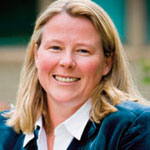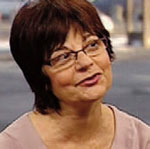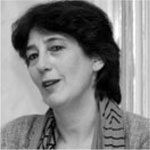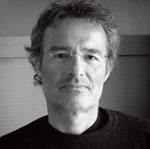A Slowly Evolving Landscape

International educators discuss testimony-based education
A conversation with Werner Dreier, Alice Herscovitch, and Karen Polak
By Kori Street
Initiated by Sweden’s then–Prime Minister Göran Persson in 1998, the International Holocaust Remembrance Alliance (IHRA)—formerly known as the Task Force for International Cooperation on Holocaust Education, Remembrance, and Research—is an intergovernmental body whose purpose is to place political and social leaders' support behind the need for Holocaust education, remembrance, and research both nationally and internationally. There are currently 31 member states. (www.holocaustremembrance.com)
The USC Shoah Foundation’s Director of Education, Kori Street, invited three leaders from the IHRA’s Education Working Group to comment on the changing landscape in the field with respect to the use of testimony. Their answers to the questions posed by our director of education suggest that there are as many questions as answers when it comes to utilizing testimony effectively in international programming. There is clearly a lack of agreement on the best practices, as well as a need for further exploration of how to use a currently underutilized resource in the field. Their thoughts contribute to an ongoing dialogue that the Institute has been engaged in for many years and indicate a need to continue our work integrating testimony into education.
 Kori Street: How would you describe the current state of play in the field of Holocaust education (broadly defined) with respect to using testimony?
Kori Street: How would you describe the current state of play in the field of Holocaust education (broadly defined) with respect to using testimony?
Alice Herscovitch: Despite efforts over the decades to record oral histories, they remain largely underutilized. However, the determination of survivors to tell their stories and to assure that they be used as tools to communicate the human consequences and to combat Holocaust denial has ensured the use of some of these oral histories in museums, exhibitions, and in pedagogical tools for teaching about the Holocaust. We are at the beginning of reflections on future use and access.
Karen Polak: Generally teachers are still too often using fictional films about the Holocaust during lesson time and not aware of the availability and possible impact of the use of testimonies. Teachers often feel that to invite an eyewitness into the classroom is “the real thing” and using video testimony is second best and therefore not considered, even when inviting someone in person is not viable.
It is still a small group of teachers that has the chance to go to seminars to get to know about DVDs and online resources that make testimonies available for classroom use. And few of them get to feel comfortable to work with testimony. It is (far) more demanding of a teacher to select appropriate testimony and to embed it in his/her lessons than it is to show a film.
 Too often, using testimony is seen as edutainment (entertainment with an educational aspect) that will appeal to students—the idea being that students will only be interested if the story is exciting and visually compelling. Students are often underestimated. However, to choose age-appropriate and relevant testimony to use in class is not an easy matter, and a wider international exchange on successful approaches will be welcomed.
Too often, using testimony is seen as edutainment (entertainment with an educational aspect) that will appeal to students—the idea being that students will only be interested if the story is exciting and visually compelling. Students are often underestimated. However, to choose age-appropriate and relevant testimony to use in class is not an easy matter, and a wider international exchange on successful approaches will be welcomed.
Werner Dreier: To the best of my knowledge the main challenge is to develop an integrative history of the Holocaust, which includes testimonies, diaries, letters, photos, etc. (personal, “subjective” sources) with academic research, thus bridging the dichotomy of personal recollection and history writing. All these aspects and sources must be dealt with in a critical way, allowing the learners to approach the subject with her/his own questions.
Herscovitch: Historians continue to debate the place of oral history and witness testimony as a valid component of history education. Discussions continue on memory versus fact, remembrance versus education. These interpretations of the construction of history are not either/or, and the strengths of each could and should be utilized.
 We are far from having defined how these testimonies can best be used to achieve these goals, and full-length testimonies, with few exceptions, are not in themselves likely to appeal to broad audiences, nor are they pedagogical in nature. However, they offer enormous potential for education and remembrance work.
We are far from having defined how these testimonies can best be used to achieve these goals, and full-length testimonies, with few exceptions, are not in themselves likely to appeal to broad audiences, nor are they pedagogical in nature. However, they offer enormous potential for education and remembrance work.
Polak: A very positive development of the last decade is that memorial sites now are including testimonies on a larger scale in their educational work—providing visiting school classes with testimony to work with before making their visit.
Street: What are the greatest opportunities and challenges facing the field today and in the immediate future, and how does visual history testimony affect them?
Dreier: The biggest challenge is that the Holocaust and the years of mass violence in Europe become a history that is often referred to but that is not really known.
Visual history testimony opens a window of interest that might lead to deeper learning processes—the opportunity. Survivors’ narratives open questions, instigate an interest, and might bring along critical appraisals of history.
Herscovitch: In terms of challenges, if we wish to record new testimonies, the time is now. There are questions to be answered regarding accessibility and use. The documentation and cataloguing of recorded testimonies are challenges for most organizations. The development of appropriate tools from long testimonies, the extraction of themes, the link with contemporary messages are all challenges. The stated expectation often heard is that recorded testimony will replace survivor in-class or live testimony. They cannot be equated. It is up to educational institutions to use video testimony, as well as archival documents and artifacts to relate the human story of the Holocaust.
 The links to other genocides and contemporary crimes against humanity, universal messages related to anti-racism and anti-discrimination or citizenship education, and comparative approaches remain challenging for educators. Centers need to find means to facilitate their work, based on training, support, and tools.
The links to other genocides and contemporary crimes against humanity, universal messages related to anti-racism and anti-discrimination or citizenship education, and comparative approaches remain challenging for educators. Centers need to find means to facilitate their work, based on training, support, and tools.
Polak: Survivors born after 1932, and certainly those born after 1942, will still be able to speak to audiences for another decade. Those who have no direct memories of the war years but who can speak clearly of the impact of the Holocaust on their lives should be encouraged to do so. Programs that facilitate the matching of schools/teachers to speakers should be supported, and professional assistance should be available.
Second-generation speakers should be part of professionally developed programs that give support and make clear what is and what is not educationally sound. Combining first-generation testimony with reflections of later generations on the testimony is an interesting new field to consider. A (grand) child reflecting on (parts) of the testimony of his/her (grand) parent can bring to life the relevance of “remembering for the future.”
Making testimony available online (well structured, with advice on how to work with it educationally) is becoming more common and more easily applicable in the classroom. However, there is still a multitude of educational and practical challenges (schools with few facilities, the lack of availability of testimony online in some languages).
Herscovitch: There has been evolution, in a positive way, in the collection of video testimony, which has broadened knowledge about and understanding of the Holocaust. With time, hidden children and noncamp experiences have gained legitimacy. The actions of righteous individuals have also been documented, and country-specific history has been shared. This is due, in part to the passage of time, but also to the power of recording human voices and stories, which lends credibility to the scope of the Holocaust and nonetheless breaks it down to its smallest but essential component, impact on human lives.
The emotional charge, the passion that can be inspired by oral history cannot be duplicated by any other means. The USC Shoah Foundation Collection and those of Holocaust institutions around the world offer an enormous wealth of human history, which is unprecedented. For students, understanding history from the perspective of those who lived through it is a unique experience. Oral-history collections offer a breadth of experiences, tell stories of life before the Holocaust, and promote understanding regarding the diversity of Jewish life and experience. They also underscore the importance of understanding antisemitism as a historical phenomenon, and help humanize, contemporize, and universalize understanding of the Holocaust.
The world is small. Remarkable technological advances have created a potential that did not exist 10 years ago. The web and social media outlets offer great opportunities for reducing distance, both geographical and historical. As an example, a school in Togo created a theatrical reading of letters written during the Holocaust from the Montreal Holocaust Memorial Centre’s collection, discovered on our website in the teachers section.
Street: What questions are we not asking or answering about the changes in the educational environment? What questions do we need to think about when using testimony to address those changes (or not)?
Herscovitch: We need to be clearer about what Holocaust education can and cannot do. We are not sufficiently responding to the rapid change in technology and expectations of students to learn through new media. Through efforts to assure that the historical method is respected, and that students gain an understanding of history, we sometimes fall short in the area of making links to the present, where relevant, and having students reflect on contemporary issues.
Additionally, although some would disagree, testimonies have an underutilized potential to inspire action. The current North American educational environment is focused on knowledge and reinvestment. We need to help educators better understand the links and distinctions to be made between Holocaust education, anti-racist education, and human rights education.
Dreier: Testimonies need a historical context. For an educational environment this asks for integration of testimonies into “ordinary” teaching—to combine them with schoolbooks or other learning programs. This also leads to the issue of mainstreaming. Dealing with Holocaust and survivors’ testimonies should be part of regular teaching.
Polak: We need to address the relevance of learning about the past in relation to the present. We can contribute to this by making testimony available in which survivors themselves reflect on this topic. Their voices can be relevant and effective. We need to look for relevant links between the threat of human rights today and the history of the early years of persecution of Jews, Roma and other victim groups (1930s). In several European countries anti-Gypsyism is a very serious threat to the lives of Roma minorities, and their human rights are not being protected by the responsible governments. Other ills and tensions in society, such as antisemitism, a general atmosphere of increased intolerance, and anti-immigrant or anti-refugee attitudes all influence teaching about the Holocaust. We need to consider how we can contribute to the deeper understanding of human rights issues by letting students reflect on this after watching testimonies that speak to these questions.
Dreier: Diversity in school classes [also] needs to be acknowledged—pinpointing specific groups (for example, “Muslims”) is more a strategy of avoidance of the pertinent questions and of dealing with diversity than it is helpful.
Street: What is the most important issue facing educators internationally? And how do you think we need to answer it?
Polak: Teachers have often not been given the opportunity to develop the skills they need to introduce complex and sensitive topics into the classroom. Too often students are considered “a problem,” lacking in interest or respect for lessons on the Holocaust. The answer to the challenge of making the history of the Holocaust interesting and relevant to students worldwide lies in developing the intercultural skills of teachers and the notion of teaching through human rights, alongside a good understanding of the history of the Holocaust and how to use a variety of sources (including testimonies) and methods in their teaching. Teachers all over the world, with students from many different backgrounds, have engaged their students in meaningful studies of the Holocaust. We need to create a better method of sharing good practices, above all, with the teacher-training institutes.
Alice Herscovitch: I am not certain that this is a question that is best answered on an international level. The Holocaust, as all other issues, is understood according to local and regional history and culture, contemporary issues and their interpretation, and national identity. Education is directly linked to these understandings. “Perpetrator” nations in themselves have adopted a wide variety of understandings of their roles and face varying challenges. Some former Soviet bloc countries are equating Jewish victims of the Holocaust with victims of totalitarian oppression, or in rare cases, assessing Jews as Soviet collaborators. “Bystander” nations reflect another broad range of understanding of their role and of Holocaust education (absent, state-mandated, voluntary). Teacher training on this subject is far from consistent, even within a given country.
If international reflection on the use of recorded testimony is to advance, there need to be discussion forums, conferences, and debate to advance on questions regarding what is available, how to make it available, pedagogical questions, and how it can be used in different country contexts. We should consider brief guidelines (international with country-specific adaptations) on the use of recorded testimony, just as many Holocaust centers have developed them on the use of survivor testimony in classrooms.
This interview appears in the Summer 2013 issue of the Institute's digest, PastForward.
Alice Herscovitch is the executive director of the Montreal Holocaust Memorial Centre. She has been a member of the International Holocaust Remembrance Alliance’s Education Working Group since 2005 and became its chair in 2013.
Karen Polak works for the International Department of the Anne Frank House as a senior staff member. She was International Holocaust Remembrance Alliance’s Education Working Group chair in 2004-2005 and has been the chair of the Working Group on the Genocide of the Roma since 2006.
Kori Street is the USC Shoah Foundation’s director of education. She came to the Institute in 2011 from Mount Royal University, where she was an associate professor and served as chair of entrepreneurship, nonprofit studies, international business and aviation in the Bissett School of Business. After completing a master’s in the History of Education and Gender/Feminism at the Ontario Institute for Studies in Education/University of Toronto, Dr. Street received her PhD in history from the University of Victoria in 2001. Dr. Street’s current work is focused on the preservation and educational use of Holocaust survivor testimonies.
Like this article? Get our e-newsletter.
Be the first to learn about new articles and personal stories like the one you've just read.